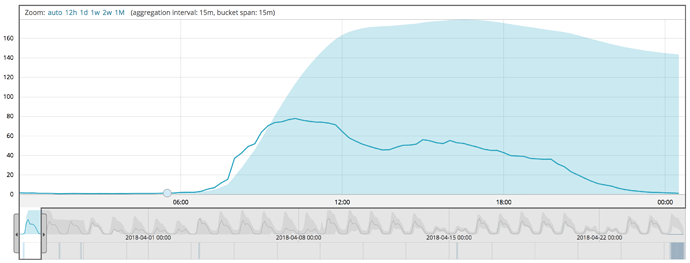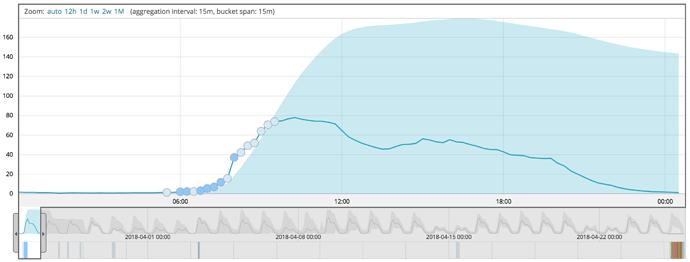Single Metric Job
{
"job_id": "single-metric-job",
"job_type": "anomaly_detector",
"job_version": "6.2.2",
"description": "Single Metric 26.03. - 26.04.2018",
"create_time": 1525781363830,
"finished_time": 1525781371280,
"established_model_memory": 65024,
"analysis_config": {
"bucket_span": "15m",
"summary_count_field_name": "doc_count",
"detectors": [
{
"detector_description": "mean(value)",
"function": "mean",
"field_name": "value",
"rules": [],
"detector_index": 0
}
],
"influencers": []
},
"analysis_limits": {
"model_memory_limit": "10mb"
},
"data_description": {
"time_field": "@timestamp",
"time_format": "epoch_ms"
},
"model_plot_config": {
"enabled": true
},
"model_snapshot_retention_days": 1,
"model_snapshot_id": "1525781370",
"results_index_name": "shared",
"data_counts": {
"job_id": "single-metric-job",
"processed_record_count": 8928,
"processed_field_count": 17856,
"input_bytes": 611262,
"input_field_count": 17856,
"invalid_date_count": 0,
"missing_field_count": 0,
"out_of_order_timestamp_count": 0,
"empty_bucket_count": 0,
"sparse_bucket_count": 0,
"bucket_count": 2975,
"earliest_record_timestamp": 1522015200000,
"latest_record_timestamp": 1524693300000,
"last_data_time": 1525781368135,
"input_record_count": 8928
},
"model_size_stats": {
"job_id": "single-metric-job",
"result_type": "model_size_stats",
"model_bytes": 65024,
"total_by_field_count": 3,
"total_over_field_count": 0,
"total_partition_field_count": 2,
"bucket_allocation_failures_count": 0,
"memory_status": "ok",
"log_time": 1525781370000,
"timestamp": 1524691800000
},
"datafeed_config": {
"datafeed_id": "datafeed-single-metric-job",
"job_id": "single-metric-job",
"query_delay": "74694ms",
"indices": [
"rest-"
],
"types": [],
"query": {
"bool": {
"must": [
{
"query_string": {
"query": "",
"fields": [],
"type": "best_fields",
"default_operator": "or",
"max_determinized_states": 10000,
"enable_position_increments": true,
"fuzziness": "AUTO",
"fuzzy_prefix_length": 0,
"fuzzy_max_expansions": 50,
"phrase_slop": 0,
"analyze_wildcard": true,
"escape": false,
"auto_generate_synonyms_phrase_query": true,
"fuzzy_transpositions": true,
"boost": 1
}
},
{
"match_phrase": {
"application_type_id": {
"query": "field-c",
"slop": 0,
"boost": 1
}
}
},
{
"bool": {
"should": [
{
"match_phrase": {
"curve_id": {
"query": "field-b",
"slop": 0,
"boost": 1
}
}
},
{
"match_phrase": {
"curve_id": {
"query": "field-a",
"slop": 0,
"boost": 1
}
}
}
],
"adjust_pure_negative": true,
"minimum_should_match": "1",
"boost": 1
}
},
{
"match_phrase": {
"ts_id": {
"query": "id-of-the-time-series",
"slop": 0,
"boost": 1
}
}
}
],
"adjust_pure_negative": true,
"boost": 1
}
},
"aggregations": {
"buckets": {
"date_histogram": {
"field": "@timestamp",
"interval": 90000,
"offset": 0,
"order": {
"_key": "asc"
},
"keyed": false,
"min_doc_count": 0
},
"aggregations": {
"value": {
"avg": {
"field": "value"
}
},
"@timestamp": {
"max": {
"field": "@timestamp"
}
}
}
}
},
"scroll_size": 1000,
"chunking_config": {
"mode": "manual",
"time_span": "90000000ms"
},
"state": "stopped"
},
"state": "closed"
}



